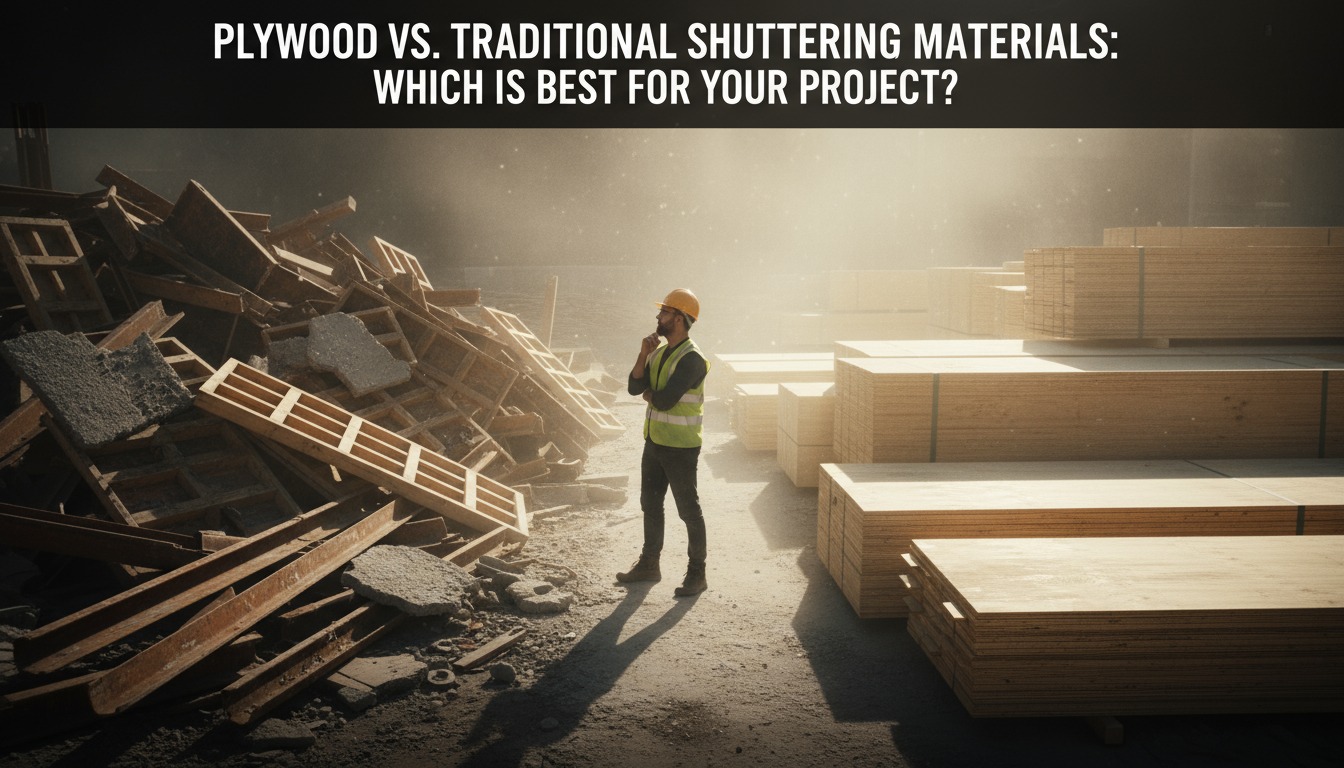Over the years, my profession has taken me to countless construction sites, from small residential builds to massive infrastructure projects. And one thing I’ve learned is that the formwork material you choose can define the success of your project. It determines how strong, smooth, and precise your concrete structure turns out to be.
For decades, contractors relied on traditional shuttering materials like steel sheets or timber planks. But with evolving construction demands, modern high-density shuttering plywood has gradually emerged as the smarter, more efficient alternative.
In this article, I’ll break down how shuttering plywood compares to conventional materials, and why it has become the go-to choice for builders who value strength, speed, and reusability.
Comparison Between Modern Shuttering Plywood Vs. Traditional Option
1. Strength and Load-Bearing Capacity
Let’s start with what matters most in the construction industry: strength. Traditional shuttering materials like steel plates are incredibly strong and can withstand heavy loads, which makes them suitable for large-scale industrial projects. However, steel formwork is expensive, heavy, and often cumbersome to handle. It requires more manpower and time to set up, which can slow down work on smaller or mid-sized projects. Timber planks, while easy to source and work with, often lack uniformity and tend to warp or split under repeated use.
On the other hand, high-density shuttering plywood strikes the right balance. It’s engineered to endure the high pressure of wet concrete without bending or cracking. Its superior load-bearing strength makes it ideal for both large and small-scale construction. Because of its lightweight nature, it’s easier to transport, install, and remove, saving both time and labor costs.
2. Surface Finish and Precision
The finish of your concrete surface depends directly on the formwork material. Steel sheets can produce smooth finishes, but they tend to leave visible joint lines or rust stains if not maintained properly. Timber, due to its uneven texture and absorbent nature, often results in rougher concrete surfaces that need extra plastering or finishing work.
On the contrary, high-density plywood delivers a uniform and smooth surface finish. Its precisely bonded veneers ensure there are no visible imprints or inconsistencies on the concrete surface. This minimises post-construction finishing requirements, reducing both time and material costs, keeping in mind today’s fast-paced construction schedules.
3. Durability and Reusability
In the long run, the reusability of formwork materials plays a major role in determining project economy. Steel can be reused multiple times, but it demands regular maintenance to prevent corrosion and surface wear. Its weight and handling also make it less practical for projects that require frequent assembly and disassembly.
Timber, while inexpensive initially, has the shortest lifespan. It deteriorates quickly due to moisture exposure and frequent nailing, often lasting for just a few cycles.
In contrast, high-density shuttering plywood offers remarkable reusability if maintained properly. Its phenol-bonded layers and water-resistant coatings ensure it withstands moisture, heat, and mechanical stress far better than traditional options. It provides a dependable balance between durability and cost-efficiency, making it a favourite option among modern contractors and builders.
4. Weight and Handling Efficiency
Anyone who has spent time on a construction site knows that handling heavy materials slows everything down. Steel shuttering systems, though robust, can weigh several times more than plywood. Also, moving them around requires cranes or additional manpower, which adds to operational costs.
Plywood, by comparison, is lightweight yet structurally sound. Workers can handle it easily without the need for special equipment, which significantly improves workflow efficiency and reduces fatigue during setup and removal. This is particularly beneficial in multi-story construction projects where formwork needs to be relocated frequently.
5. Cost-Effectiveness Over Time
Cost is always a deciding factor, and here’s where plywood truly stands out. While steel offers longevity, its high initial investment and maintenance costs can strain smaller project budgets. Timber, though a cheaper option, ends up being more expensive due to frequent replacement.
High-density shuttering plywood, however, offers a balanced solution. It’s affordable, reusable, and durable, making it one of the most cost-effective materials for contemporary formwork systems. For contractors aiming to optimise both quality and cost, plywood offers long-term value that’s hard to beat.
6. Environmental and Practical Benefits
Sustainability has become a key priority in construction. Compared to steel and timber, engineered plywood has a smaller environmental footprint when sourced responsibly. It requires less energy to produce and supports efficient material reuse, contributing to more sustainable construction practices overall.
Its smooth finish also reduces the need for additional surface treatments, minimising waste and secondary materials. This approach aligns with the industry’s growing focus on efficiency and eco-conscious design.
How a Smarter Alternative Can Change the Game?
From strength and surface quality to cost and sustainability, high-density shuttering plywood clearly stands out as the modern choice for builders who don’t want to compromise. However, the real difference comes from where you source it.
This is where United Timber Works earns its reputation. As a trusted manufacturer of high-density shuttering plywood, the brand focuses on precision bonding, durability, and consistent performance across every panel. In addition, each sheet is crafted to handle the rigors of heavy concrete pressure, repeated reuse, and challenging site conditions, ensuring that every pour results in flawless concrete formwork.
In short, United Timber Works’ plywood blends strength, reliability, and efficiency, making it an ideal partner for builders who value long-term results over short-term savings.
Final Takeaways
In the debate between plywood, steel, and timber, the winner isn’t hard to see. High-density shuttering plywood delivers unmatched versatility that combines the strength of steel, the workability of timber, and the modern innovation that today’s construction demands.
For those of us who believe in building smarter, faster, and stronger, the choice is clear. And when you choose quality plywood from a reliable name like United Timber Works, you’re investing in the lasting integrity of every structure you build.


